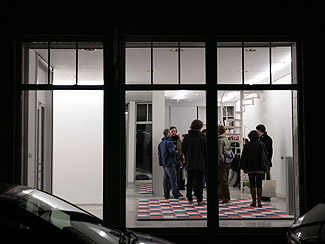The exhibition “Heaven is a Place on Earth” in Mayerei shows Jacob Dahlgren's conceptually oriented positions, which are located at an interface between photography and sculpture.
Dahlgren highlights variations of basic graphic elements by taking photographs of diverse striped subjects, which he encounters on the decorative surfaces of everyday objects; these are compiled under the title “Signs of Abstraction”.
Jacob Dahlgren makes collecting a principle: as an archivist who sees the world in patterns he meticulously accumulates various manifestations of similar structures, which he interprets as seemingly abstract applications within a given context, and finally denotes as objets trouvés.
The single shots are classified into image families, which as a whole allow an algorithm to become visible. Variation and repetition play only the role of marking the serial incedence and therefore the consistency of laconic structures as conventional patterns.
The focus is not on the subject of the photo itself, but on the symbol-enriched situation that Dahlgren captures in his images. The photo series “Signs of Abstraction”, which began several years ago, comprises a mass of over 50 000 pictures, an excerpt of which is being shown at Mayerei.
Twelve 23 x 31 cm photographs were chosen arbitrarily by the artist. Whether construction site fencing, flags or supermarket interiors – all shots have striped patterns in common. The situational condition becomes the principle of the picture: The viewer sees four women with four different striped shirts in one picture, in the other there are two red and white striped cement mixers placed mirror-symmetrically on an island. It is the abstruse and likewise funny aspect of the banal that Dahlgren unites in his transient image compositions.
For the large part the pictures exist as untitled parts of an ongoing series. The unimportance of naming the individual pictures underlines not only the timelessness of the patterns, which Dahlgren promotes to permanently popular designs as conventional symbols, but also the situationality which the artist captures in his spontaneous shots.
The isolation of the image from its context via photography is countered in a subsequent assembly by Dahlgren. With the juxtaposition of the pictures the reciprocal effect of these apparitions becomes the topic of the essential contemplation. Dahlgren's intention is less the concrete referral to the surroundings of these image details than the disengagement from context-related contemplation in general. He aims at an abstraction of the depicted by presenting fragments taken from an actual environment. The encountered, random composition ultimately brings about the construction of the image, manifested by Dahlgren's photographic framing.
By playing with colour and shape he makes a reference to the mobile configuration of abstract picture elements in Modernism. Instead of using paint, Dahlgren creates collages out of objects, constructed of reality's props.
Based loosely on Wassily Kandinsky's thoughts on painting, Dahlgren objectifies the idea of progressing from a dot to a line to a surface and finally, to a body, thus creating sculptures that not only fill the room with their haptic presence, but also demand of the viewer an active intervention with the objects made by him.
Interactivity is part of the concept – under the motto “Signs of Abstraction” the visitor of his exhibition is invited to wear a striped shirt to a party initiated by the artist. He sees movement as the performative and conjunctive element of his art.
This is manifested in the object “Heaven is a Place on Earth”. Consisting of 164 bathroom scales, arranged over a surface of 380 x 420 cm, the visitor of the exhibition is compelled to set foot on the installation. Stepping on a scale is a familiar act, but here it takes on a modified shape.
Dahlgren complies with a convention of action in this, but prevents its conventionality through varying details. The joint influence of the path taken and the pace creates a rhythm that only the visitor determines. The impact of the visitor's own bodily presence on the sculpture imparts the external visible structure an inner version that can be ascertained pre-eminently by the visitor only.
Jacob Dahlgren shows the viewer a subversive analysis of manifestations of abstract art that he reclassifies from within everyday life and unveils. In doing so he undermines the dogmatic construction of images and establishes a space that is subject to subjective association. By decontextualising the trivial via reintegration within a frame of reference defined by Dahlgren, he places the tangible in an artistic, abstractive image sequence. With his focus on detail Dahlgren not only sharpens one's eye for the sign-endowed furnishings of daily routine, but also offers the viewer the possibility to discover the symbolic within the commonplace.
Christina Irrgang |
